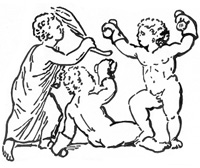When I began substituting as a coach for a boxing club, which operates out of a kenpo school, I ran into two problems:
1. There was not a separate boxing area, so boxing could not occur during peak hours.
2. Boxing sessions were done along the lines of ‘a private’ in martial arts or personal training terms. The corollary in boxing terms is solo coaching in preparation for an upcoming fight of the sort typically enjoyed by elite amateurs, professional prospects, contenders or champions. This format resulted in boxers getting their skill set with me and going elsewhere for conditioning. You don’t want your people going elsewhere.
#1 was easy to satisfy. The back corner of the school was made into a miniature boxing area consisting of a wrestling mat ringed by punching bags. This area doubles as a grappling/MMA area, so has value to the self-defense program and can sustain a handful of boxers while karate class is in session.
#2 was a tougher question. Martial arts and fitness privates are expensive; too expensive to serve as a fitness routine. Fitness provides much of the appeal of boxing, particularly to the extent that people will look for it in a white collar setting. To utilize boxing as a conditioning regimen or to gain enough functional proficiency to apply the skills for competition or self-defense, requires at least two sessions per week, ideally 3 or 4. This puts the boxing session priced as a private out of reach for the boxer and too labor intensive for the coach, severely limiting the number of boxers he can handle.
The answer came in the form of a venerable martial arts tradition, the ‘mat fee’, to pay for solo training sessions in between privates. Boxing, like other combat sports, requires a higher degree of simple repetitive skill conditioning than traditional arts. It also requires the apparatus in the gym [dojo]. Therefore solo training, lightly supervised by a coach that will bark about a closed guard or a dropped lead while the boxer is hitting the bag, is necessary for technical progress as well as fitness. This is why solo training, barely supervised, is the predominant activity of most boxers in the gym.
I currently recommend training to instruction sessions according to the following ratios, depending on the boxer’s skill level:
Unskilled: 1 training to 1 instruction
Marginally skilled: 2 training to 1 instruction
Skilled: 3 training to 1 instruction
Skilled enough to spar: 4 training to 1 instruction. [I like taking the sparring out of school as a free field trip.] Sparring is a tricky combat sport question that bears heavily on functional skill development and student retention. I will cover sparring in a sequel.
Below is the solo training regimen posted in the miniature boxing gym in the back of the martial arts school where I coach.
Boxing Conditioning Set
Conditioning is to be done according to timed rounds for competitive fighters and untimed rounds for fitness boxers.
Warm ups
1. neck rolls
2. shoulder rolls
3. wrist rolls
4. waist rolls
5. hip rotators
6. knee touches
7. ankle rolls
8. toe-heel rocks
Bag Work Rotation: 3 rounds each
1. Line drill
2. Shadow boxing
3. Reflex bag
4. Heavy bag
5. Double-ended bag [or slap the heavy bag]
6. Speed bag
7. Guarding & countering drills
Floor Work [1-3 sets each]
1. Side bends
2. Medicine ball
3. Crunches
4. Jumping jacks or skipping rope
5. Stretches: calf, hamstring, hip, shoulders, forearms











